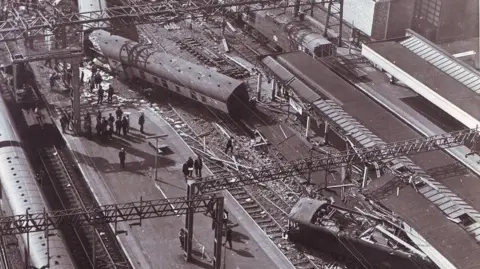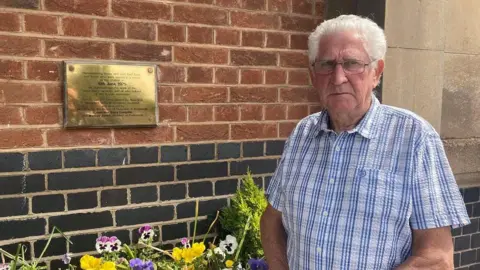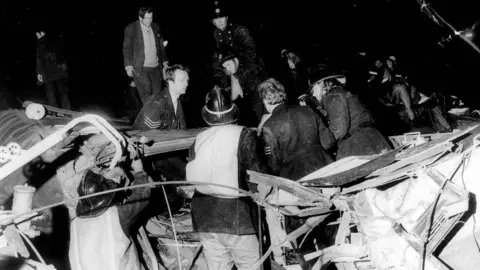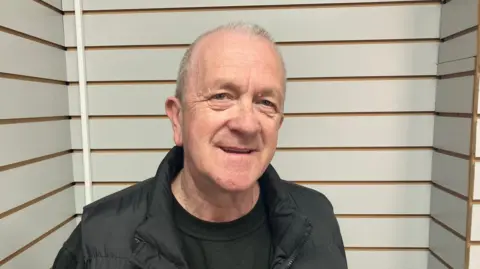Former firefighter remembers fatal 1975 rail crash
On 6 June 1975, firefighter Norman Winnett was nearly six hours into a night shift when the call came in to say a train had crashed at Nuneaton railway station.
He was first at the scene where an overnight sleeper train with 12 carriages had derailed, smashing into a platform and killing six people. Dozens more were injured.
"We could hear voices, we could hear people who wanted to get out," Mr Winnett remembered of the wreckage.
The story of what happened is being retold by the BBC's Secret Warwickshire series.
 Walter Bloxham/Warwickshire Police/Nuneaton Memories
Walter Bloxham/Warwickshire Police/Nuneaton MemoriesThe Euston to Glasgow service was running late that night after breaking down in Hertfordshire and the train was more than an hour behind time.
As it neared Nuneaton, travelling at about 80mph, the driver saw a board warning of a 20mph speed restriction through the station. The safety measure had been brought in for temporary track there which could only sustain top speeds of 40mph.
The lights on the board were out and the driver wrongly assumed that meant the restriction was lifted, with catastrophic results.
 Walter Bloxham/Warwickshire Police/Nuneaton Memories
Walter Bloxham/Warwickshire Police/Nuneaton MemoriesAs the train was about to enter the station shortly before 02:00 BST, the driver saw another warning board which was lit and slammed on the brakes but "it was by then too late", a report into the crash said.
The two engines, along with all the sleeper cars, derailed. Coaches slewed sideways, some thrown on to their sides, hitting structures along the line for 340 yards (311m).
The engines split apart and the second one smashed on to a platform.

When Mr Winnett arrived he could see the scale of disaster and more fire crews were quickly called to the scene but they struggled to get to survivors.
"We were having to help people get out with crowbars, saws and jacks," Mr Winnett recalled.
"We had a difficult job getting in, train carriages are made of substantial stuff. We didn't have the cutting equipment they have now."
 Walter Bloxham/Warwickshire Police/Nuneaton Memories
Walter Bloxham/Warwickshire Police/Nuneaton MemoriesPassengers who managed to get out offered to help and Mr Winnett said they were handed crowbars.
It took nearly six hours after the crash before the last injured person was rescued.
Four people - two passengers and two sleeping car attendants - were killed in the derailment, while two more passengers later died in hospital.
Sleeping car attendants Henry Chalmers, 62, from Glasgow and Abdul Bakil, 39, from Wembley, died in the crash.
As did 42-year-old William Forrest, a businessman from Glasgow, 42-year-old company director Michael Harry Allan, from Surrey, 20-year-old music student Susan Connell, from Aberdeen and Bruce Johnston, 28, a finance manager from Petersfield.
Thirty-six others who were hurt were also taken to the town's Manor Hospital for treatment, including Minister of Agriculture Fred Peart.
 Walter Bloxham/Warwickshire Police/Nuneaton Memories
Walter Bloxham/Warwickshire Police/Nuneaton MemoriesNow 80 years old, Mr Winnett said he had some sleepless nights after the crash and one or two dreams.
"I was able to forget about it for some time but you'll see an anniversary and it brings it back again," he added.
A Department for Transport report found the driver had failed to remember instructions about the temporary stretch of track in the station.
The inquiry concluded the main cause was excess speed but a secondary factor was the poor warning sign, unlit because the gas supply had run out due to incorrect use of the equipment.
The driver was subsequently charged with six counts of manslaughter but found not guilty after a three-day trial in 1976 and discharged.

Some of the photographs featured in this article were taken in the early hours of 6 June 1975 by local man Walter Bloxham - images that were later shared with the Nuneaton Memories history group.
"He'd finished a night shift" said Mark Palmer from the organisation. "On his way home it took him over the Leicester Road bridge and he saw mayhem.
"He went home, picked up his camera and came back and took these photos."
In 2015, a plaque was unveiled at the station to mark the 40th anniversary of the crash - a memorial organised by Mr Palmer.
"This town comes together in times of sadness, tragedy," he said. "The town is a very giving town."
Follow BBC Coventry & Warwickshire on BBC Sounds, Facebook, X and Instagram.
